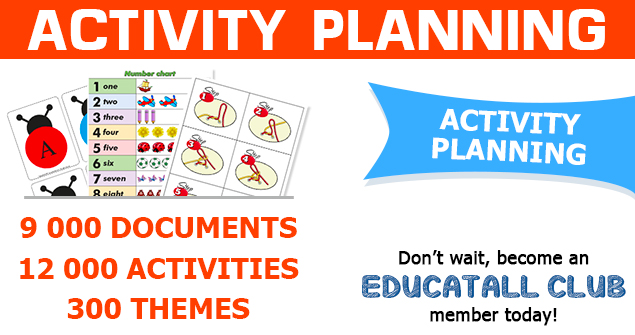
Accompanying a child with Trisomy 21
When preparing to welcome a child with special needs in your daycare, it is of utmost importance that you know the deficiency, illness, or handicap which affects the child. To help you, I will share my research on children with Trisomy 21 with you. This document is a tool which may be used to ease the integration of children with Trisomy 21 in daily daycare life. It is not an intensive theoretical lesson on the matter. However, to make is easier to understand I will approach the cause and consequences of Trisomy 21 in general before discussing a more practical aspect.
A little theory...
Trisomy 21 is also known as Down syndrome. This name comes from the fact that one of the first doctors to have identified the symptoms related to the disease was called Dr. Langdon Down. Trisomy is caused by a genetic problem which occurs during conception. Of course, genetics is a very important and complex field so, without going into details, I will share a few facts which allow for a better understanding of the existence of Trisomy 21.
During conception, our parents transmit 46 chromosomes to us. These chromosomes make up our genetic baggage. They associate together to form 23 pairs which will, in a way, create us and decide, among other things, the colour of our eyes and hair. Sometimes, difficulties arise and an extra chromosome joins the 21st pair. Consequently, the child becomes trisomic. The number 21 accompanies the term trisomy because the anomaly occurs with the 21st pair of chromosomes. Other types of trisomy exist due to an extra chromosome joining other pairs (Trisomy 18, for example). These other types of trisomy usually provoke the death of the fetus before it reaches full-term.
Symptoms associated to Trisomy which are frequently observed in children are intellectual delays, weak muscle tone, and language delays which are particularly due to the morphology of their face, mouth, tongue, and dentition.
Trisomy 21 is frequently accompanied by cardiac and digestive problems as well as other dysfunctions. Specialized care and particular precautions are required.
Preparing integration...
The integration of a special needs child can offer several advantages for everyone involved in the process. However, the integration must be well-prepared. Preschool-aged children with Trisomy 21 are hardly aware of their differences. For this reason, they usually fit right in with the rest of the group.
It is highly recommended that you prepare your group a few days before the arrival of the child with Down syndrome. You may, for example, show them a photograph of the child, and inform them of his interests and what he likes. Reading a few children's books on the subject can be a good way of introducing the topic. Glue a few pictures of children with Trisomy 21 going about their daily activities in the daycare.
Normally, children with Trisomy 21 are under the care of a rehabilitation centre. It is very important that your work in collaboration with the centre's personnel, the child's parents, and your local CLSC. They can all be helpful. Do not hesitate to ask them for information regarding the child's particularities and Trisomy 21 in general. As long as the child attends your daycare, inform them of any changes or interrogations you may have. Collaboration is essential to ensure the child's integration unfolds as planned.
The practical side...
Trisomic children have several common physical features. Other than these resemblances, they are all unique. They all have different needs, personalities, characters, likes, and dislikes. The descriptions and suggestions mentioned in this document refer to general characteristics frequently observed in trisomic children. Consideration of each child's particularities is strongly recommended when using the interventions.
The intervention method you must favour is almost identical to the one you already use on a daily basis with your group. As for all children, you must respect their rhythm and identify their needs and interests after careful observation. Because of developmental delays due to Trisomy 21, the child may require additional support and stimulation. However, overstimulation may be a trap. As in everything else, moderation is best!
Area setup...
Rethink the layout of your furniture and toys to respect any particular needs parents may have mentioned. For the child to feel safe, he must be able to easily recognize his surroundings.
Play areas and toy bins must be well-identified. Use illustrations. It is easier for children with Trisomy 21 to associate an object to an illustration which is very close to reality. You may choose to photograph the toys each bin contains.
A view of the entire daycare must be possible. The child must be able to see you when he is playing and locate you easily. Your daycare must contain wide open spaces which allow the child to move about comfortably since sudden, involuntary movements are frequent. Hypertonia is a common symptom in children with Trisomy 21. Consequently, a chair which is specially suited for the child must be accessible since his attention level can be considerably reduced if he is not seated properly.
Purchase material which stimulates the senses and is easy to hold and manipulate. It must be attractive and have multiple uses thus encouraging imagination and spontaneity. Keep in mind that trisomic children's hands are shorter and wider which can make fine motor skills difficult. Here are few suggestions of appropriate material: large waxed crayons and markers for beginners, puzzles with small handles on each piece, large LEGO blocks, plastic cars normally used by very young children, etc.
Interventions...
- To capture trisomic children's attention, it is best, in general, to reduce the number of stimuli. It is suggested that the door of the daycare remain closed. When you need the child's attention, it may be useful to stand in front of a blank wall. Avoid standing in front of a window since several distractions may occur outside. Having the child sit near you when you are speaking eases comprehension and participation.
- You must be able to offer stability: consistency in your instructions, a regular routine, and no changes in personnel. Instructions must be simple and given on the spot. Avoid giving several instructions ahead of time. To help him visualize general rules, display the educatall club's Friendly Advice Caterpillar. (Open Friendly Advice Caterpillar) Most children with Trisomy 21 have difficulty facing change. To help them, a practically identical routine must be used day after day. What's more, it must be illustrated. To help the child identify each part of the day, use photographs you have taken of your group during different periods in the day. Another way of facing small daily changes is to display a large calendar. With the help of pictograms, identify everything which will take place during each month: birthdays, outings, holidays... Remember to identify your absences and add a picture of the person who will be replacing you.
- Favour self-esteem and confidence. Encourage trisomic children to persevere. They have a tendency to abandon quickly. However, be sure not to overprotect them. Like all children, they need to have successes as well as defeats. This will help them mould their personalities and acquire new skills.
- Children with Trisomy 21 learn very well through imitation. When you use a gesture or a particular action, explain the reason behind it. This will transform the moment into a learning experience instead of just simple imitation. When learning something new, the child must be able to repeat the action several times before acquiring it.
- The importance of integration is above all to help the child develop abilities which will make living in society easier. You may do this by planning activities in which the child must work with a teammate, share material, or respect precise rules. You must also give him the necessary tools to face eventual conflicts. Display the educatall club's Problem Solving Rainbow. (Open Problem Solving Rainbow) This will allow him to visualize the steps whenever necessary.
- Most activities you normally enjoy with your group are possible. They may require a minor modification on your part. You must adapt them to the child's personality and level of development. Sometimes, just reducing the number of rules or the quantity of material required is enough. You may also modify the area setup. Do not set too many goals for yourself. Concentrate on the learning process instead of the end result. Never forget that you cannot change the child's condition but that you do have the chance to help him enjoy being a child!
Making specific material...
- Provide the child with a small box which contains several pictograms which identify objects, activities, and emotions he encounters on a daily basis. Since trisomic children generally have language delays, the child can use the pictograms to verbalize a message.
- Songs are a great way to encourage language. Create a song wall and regularly display illustrated songs. Make your own song book. The child may consult it whenever he wants which will multiply singing occasions!
- Trisomic children generally demonstrate an interest in reading. Use this interest to develop the child's language by presenting him, among other things, with picture clue stories. You can even make your own. Choose a children's story and select a few key sentences which have a logical sequence. Choose short, simple words in each sentence and replace them with small illustrations. Arrange the story so it fits on a single page to make it easier to use. Laminate your story. Make several and leave them in your reading corner. You may use them during story time.
- Children with Trisomy 21 enjoy all activities related to their senses. However, they have certain tactile defences in regards to touch. This means that certain textures can be unpleasant for them. They may even refuse to touch certain textures altogether. Furthermore, they dislike being dirty. If you make texture stockings you will allow them to discover new textures while respecting their situation. Insert Jell-O, rice, macaroni, flour, or other items in nylon stockings.
Sonia Leclerc
Daycare worker
No element of this text may be copied, reproduced, distributed, published, translated, downloaded, posted, or transmitted, in any way, without prior written authorization from Educatall and the copyright holder. Elements may be posted and/or downloaded solely for personal and non-commercial use provided no modifications are made and all notices of intellectual property are fully shown (name of the author, title of the article, name of the website, date the text is used and the date of the part in question).

 Home
Home Theme activities
Theme activities
 Babies and toddlers
Babies and toddlers
 Arts and crafts
Arts and crafts
 Science
Science
 Creative recipes
Creative recipes
 Tips and tricks
Tips and tricks
 Special needs
Special needs
 Extra activities
Extra activities
 Educ-TV
Educ-TV
 Newsletter
Newsletter  Online store
Online store Educatall club
Educatall club

